In the lead-up to season three of Star Trek: Picard, Keith R.A. DeCandido will take a look at the last couple of times The Next Generation crew was together: the feature films Insurrection (1998) and Nemesis (2002). In addition, you can revisit his rewatches of Generations from 2017 and First Contact from 2013.
Star Trek: Nemesis
Written by John Logan & Rick Berman & Brent Spiner
Directed by Stuart Baird
Original release date: December 13, 2002
Stardate: 56844.9
Captain’s log. We open on the Romulan Senate, where a military delegation led by Commander Suran is having their petition for the senate to support an alliance with Shinzon of Remus denied by Praetor Hiren. Senator Tal’aura then departs the chamber for a meeting, leaving a doodad behind. Said doodad opens up and unleashes thalaron radiation in the chamber, turning everyone inside to dust.
We cut to the Denali Mountains in Alaska on Earth, where Riker and Troi have just gotten married, and Picard is giving a best-man speech. We learn that Riker has been given the captaincy of the U.S.S. Titan, with Troi accompanying him, and Data being elevated to first officer of the Enterprise. Data, for reasons passing understanding, decides to sing “Blue Skies” as a “present” to the assembled multitudes.
The Enterprise later heads toward Betazed for a second ceremony, but en route—amidst some tired and puerile discussion of the fact that at Betazoid weddings everyone is naked—Worf picks up some positronic emissions on a planet near the Romulan Neutral Zone. This means there may be an android on that world. They go to investigate, taking a shuttle down and driving around on a Space Dune Buggy called the Argo that Picard is eager to take for a test drive. They find various body parts, eventually culminating in a head that looks just like Data. The natives of the planet shoot at them so Stuart Baird can direct a car chase, and they escape to the shuttle with derring-do and head back to the Enterprise. It turns out that this is B-4, a pre-Lore and pre-Data prototype constructed by Dr. Noonien Soong and Dr. Juliana Tainer (though Tainer isn’t mentioned because we all know that girls aren’t supposed to do science). Data downloads his memories into B-4, hoping it will help him find a personality, as he’s very simplistic and has trouble with all but the most basic concepts. La Forge warns him that it may not work, as B-4’s neural net is far more simplistic than Data’s.
Starfleet Command then hails Picard in the person of Admiral Kathryn Janeway: there’s a new praetor of the Romulan Star Empire, and he’s a Reman named Shinzon. They’ve requested a Starfleet vessel to open peace talks and the Enterprise is closest to the Neutral Zone. So they head off, despite the fact that they’ve got a wedding to get to.
Data briefs the crew on the Remans. Second-class citizens in the empire, they mostly do mining and heavy-weapons construction on the inhospitable Remus. They also served as cannon fodder during the Dominion War. They figure the only way a Reman could become praetor is via a coup d’état.
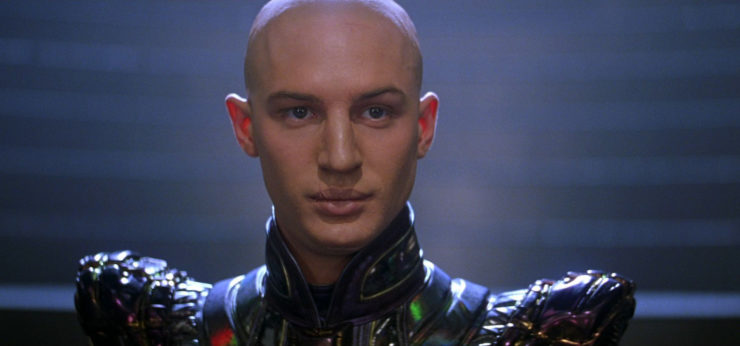
They meet with a huuuuuge Romulan ship, the Scimitar, commanded by Praetor Shinzon—who, it turns out, is biologically human, and who bears more than a passing resemblance to Picard. An away team led by Picard beams over into a very dark space. Remans are sensitive to light. Shinzon says that he wants to speak of peace between their nations. He invites Picard to join him for a meal the next day, and also provides a blood sample. Crusher examines the latter back on the Enterprise, confirming that Shinzon is a clone of Picard.
Shinzon meets with his military support: Commanders Suran and Donatra and Senator Tal’aura. Suran is pissed because they supported him because he promised to open a can of whupass on the Federation. Shinzon pleads patience, and also privately tells Donatra that she should keep an eye on Suran and maybe kill him if he gets out of line.
Picard makes the dinner date, and Shinzon explains that he was part of a program to clone prominent Starfleet personnel and replace them. But the project was abandoned, and Shinzon was exiled to the Reman mines to die. But a Reman (who now serves as Shinzon’s viceroy) took him under his wing, and he thrived.
When Picard returns to the Enterprise, Worf reports unauthorized computer activity, though they can’t localize it, and it’s nothing classified or vital. In addition, La Forge scanned thalaron radiation on the Scimitar, which is incredibly—and instantly—deadly (as we saw at the top of the movie). The presence of this radiation in such large amounts proves that, whatever Shinzon wants, peace ain’t it.
Troi gets Riker to stop focusing on work and come to bed. But their sweet, passionate nookie-nookie is interrupted by the viceroy using his telepathy to insert Shinzon’s image into Troi’s mind’s eye. She eventually is able to break contact, but the damage is done—Troi is devastated, having been psionically raped.
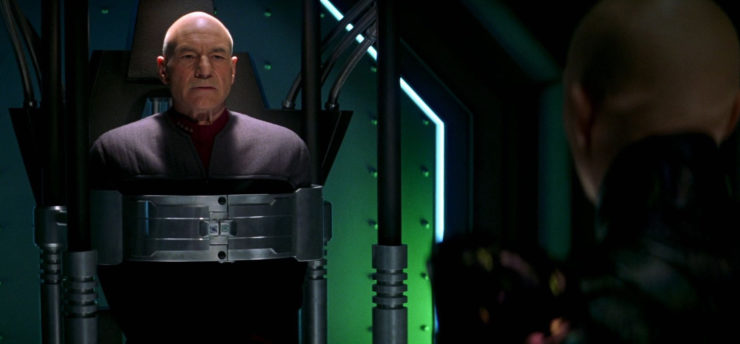
Shinzon’s physical condition is deteriorating. The viceroy reports that they’ve received the transponder signal, and they can’t wait around anymore. The doctors are standing by. He orders both B-4 and Picard to be beamed over. Shinzon orders the android to have the information he downloaded from the Enterprise be put in the Scimitar’s database and then to be removed from his sight. Shinzon intends to transfuse Picard’s blood to himself, as he’s dying—which Crusher already figured out from the blood sample. The rapid-aging he was subjected to needed to be reversed after a certain point, but it wasn’t because the mission he was created for was cancelled, and he wasn’t expected to live this long in the mines.
The android later comes to where Picard is being held prisoner, telling the guard that Shinzon wants the prisoner. Then he uses a Vulcan neck pinch on him. It’s not B-4, it’s Data. They found the prototype’s subterfuge and Data took B-4’s place, changing the data that B-4 downloaded so that it provides disinformation to Shinzon about the deployment of Starfleet.
Picard and Data steal one of the Scimitar’s support craft and fly it through the ship’s corridors until they find a window and crash through it.
Suran once again bitches to Shinzon, who assures him that the Enterprise won’t make it out of the Neutral Zone and that the Federation will be toast in a couple of days. After Shinzon breaks the connection, Suran, Donatra, and Tal’aura confer over how crappy Shinzon looks, and Donatra also raises a concern that Shinzon isn’t going to invade the Federation, but annihilate Earth and possibly more planets, not just military targets. Do they want that much innocent blood on their hands?
The Enterprise will rendezvous with a fleet in Sector 1045. They pass through Bassen’s Rift en route, and that phenomenon will disrupt communications. Sure enough, Scimitar—which can fire while cloaked—choses that moment, when the Enterprise can’t call for backup, to attack.
The battle goes really badly for our heroes, as they can’t get a bead on Scimitar except by firing wildly, then focusing weapons fire on the spot where there’s a shield hit, but Scimitar moves out of the way before they can take advantage. Meanwhile, Scimitar’s weapons are pummeling the shit out of the Enterprise, at one point taking out the viewscreen.
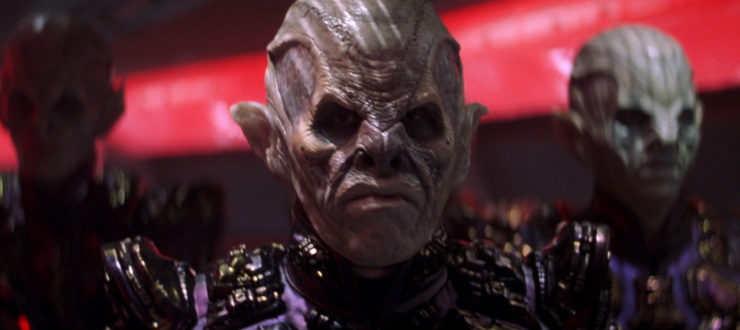
Two warbirds show up in the rift and, to everyone’s surprise, help the Enterprise. Donatra tells Picard that this is an internal matter for Romulus and she’s sorry he’s involved. Unfortunately, the Scimitar pummels the crap out of both of Donatra’s ships. However, their distraction gives Troi the chance to try to reverse the mental link the viceroy established when he raped her and uses it to help Worf track the Scimitar. Their weapons fire combined with the damage Donatra did is enough to drop Scimitar’s cloak.
But Enterprise’s shields are down, and Shinzon is able to send over a boarding party led by the viceroy. Riker and Worf lead a security detail to stop them, and I’m waiting for someone to order the lights turned on very bright. Worf and the security team take out the Remans while Riker and the viceroy get into an extended mano-a-mano in a Jefferies Tube, including at one point them both dangling over an inexplicably large chasm in the middle of the starship, down which the viceroy eventually plummets to his doom. At no point has anyone ever turned the lights on very bright, for reasons passing understanding.
Picard orders the Enterprise to ram the Scimitar, which Shinzon was not expecting. At this point, Shinzon is clearly on his last legs, and he orders the thalaron beam activated to wipe out the Enterprise, even though killing Picard means his own death. However, Picard has La Forge use the last of the transporter power to beam him over to the Scimitar. Data, however, refuses to let Picard act alone, so he goes with La Forge to where there’s a hull breach and leaps across the void to the Scimitar.
Picard is able to make it all the way to the bridge of the ship, taking out all the Remans, who were apparently trained in gunplay by Stormtroopers based on their inability to ever hit what they’re shooting at. Picard and Shinzon have a final confrontation that ends with Picard impaling Shinzon on a really big pole, enabling Shinzon to have some ridiculous final words about destiny before croaking.
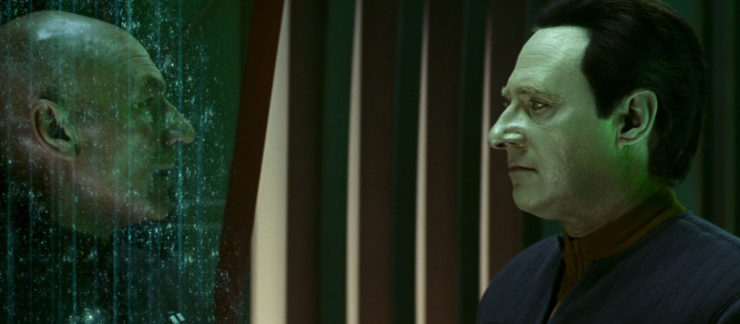
Data has a mini-portable transporter and puts it on Picard to beam him back to the Enterprise bridge. Data then blows up the thalaron weapon, which destroys the Scimitar with Data on it.
Donatra offers technical and medical assistance, which everyone hopes is the beginning of a beautiful friendship (and probably led to Picard advocating for the Romulans, as seen in the backstory for Picard season one). Eventually Enterprise limps back to Earth for repairs. Whether or not the wedding on Betazed ever happened is left as an exercise for the viewer. (Given that it was probably planned by Troi’s mother Lwaxana, the notion that it was cancelled is, um, unlikely.)
Picard sends Riker off to take command of the Titan and then tells B-4 all about Data, which B-4 doesn’t seem to comprehend in the least. B-4 then starts to sing “Blue Skies.”
Can’t we just reverse the polarity? Scimitar can fire while cloaked, because the plot wouldn’t work otherwise.
Thank you, Counselor Obvious. Troi is mentally raped, which—unlike when it was done in The Undiscovered Country—is an act committed by the villains of the piece, which is as it should be. She also gets some of her own back by using that rape to track the cloaked Scimitar.
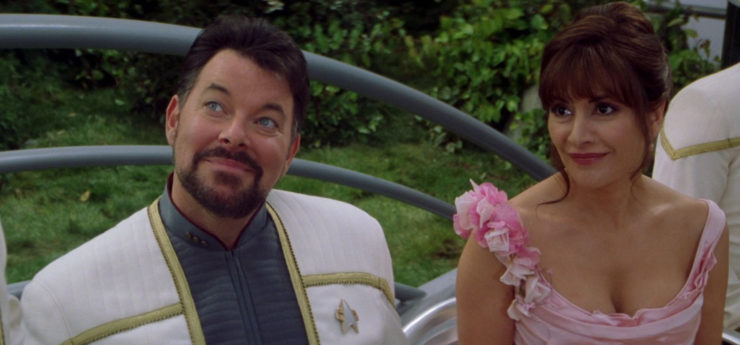
There is no honor in being pummeled. Despite having spent four years as the strategic operations officer of a critical sector, two of those years in the middle of a war, and also being in command of a warship, Worf is now serving at tactical on the Enterprise, a position he had three grade ranks ago. Sure.
If I only had a brain… Data sacrifices himself to save Picard. At the time it was believed that Data’s death was at least in part because it was getting progressively harder to convincingly have the unaging android be played by an aging actor, though that didn’t stop them from bringing Data back two decades hence in Picard season one…
No sex, please, we’re Starfleet. Riker and Troi’s attempt to have some nookie is ruined by Shinzon and the viceroy’s telepathic rape. In addition, Picard at one point “jokingly” refers to Riker as “Mr. Troi,” to show that he’s an emasculated husband now at the mercy of his wife, because apparently this movie takes place in 1949 rather than 2379…
What happens on the holodeck stays on the holodeck. Shinzon uses a holographic communicator to talk to Picard at one point. This is, by the by, the only one of the TNG movies that doesn’t have any scene on a holodeck of some sort.
In the driver’s seat. Poor Lieutenant Branson only gets a few lines of dialogue before he’s redshirted out the viewscreen after it’s blown away.
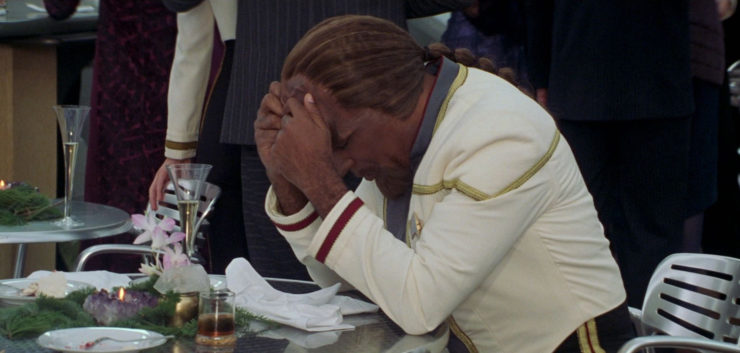
I believe I said that.
“Romulan Ale should be illegal.”
“It is.”
–Worf, drunk, and La Forge, sober.
Welcome aboard. Besides the regular folks, we have an uncredited cameo by Whoopi Goldberg as Guinan, last seen in Generations, and to be seen next in Picard’s “The Star Gazer.” There’s also a credited cameo by Wil Wheaton as Wes Crusher, seen in uniform without explanation; last seen in TNG’s “Journey’s End,” he’ll next be seen in Picard’s “Farewell.” Kate Mulgrew also appears as now-Admiral Janeway, last seen in Voyager’s “Endgame,” and next seen in Prodigy’s “A Moral Star, Part II.”
Future Oscar nominee Tom Hardy plays Shinzon in one of his earliest roles, while veteran Ron Perlman plays Shinzon’s viceroy. Michael Owen plays Branson, Shannon Cochran plays Tal’aura (she previously played Martok’s wife Sirella in DS9’s “You Are Cordially Invited” and a Maquis in TNG’s “Preemptive Strike” and DS9’s “Defiant”), Dina Meyer plays Donatra, Jude Ciccolella plays Suran, Alan Dale plays Hiren, and J. Patrick McCormack plays a Romulan commander (he previously played an admiral in DS9’s “Dr. Bashir, I Presume?” and a Devore in Voyager’s “Counterpoint”).
Trivial matters: This film was not necessarily intended to be the last film featuring the TNG crew—pre-film publicity was inconsistent on the subject—but once it was released to horrible reviews it was pretty clearly stated as this crew’s swansong, a declaration that lasted right up until Secret Hideout expanded its Star Trek output beyond Discovery in 2020. Riker, Troi, and Data will next appear in Enterprise’s “These are the Voyages…” (taking place concurrently with TNG’s “The Pegasus”) with Riker and Troi’s next chronological appearances being in LD’s “No Small Parts.” Picard will next appear in Picard’s “Remembrance.” Crusher will next appear in Prodigy’s “Kobayashi.” Worf and La Forge will next appear in the upcoming third season of Picard.
Data was established in TNG‘s “Datalore” as having been created by Dr. Noonien Soong, which also established that there was a previous model called Lore. We got more background on his creation in the TNG episodes “Brothers,” “Silicon Avatar,” and “Inheritance,” the latter of which established the existence of several pre-Lore prototypes, of which B-4 is obviously one.
This movie has references to all four other extant TV series at the time: Riker makes reference to a maneuver named after Kirk from the original series, Shinzon is described as having fought in the Dominion War from DS9, we see Janeway from Voyager, now an admiral, and the Enterprise is set to rendezvous with a fleet that includes the U.S.S. Archer, named after the captain from Enterprise.
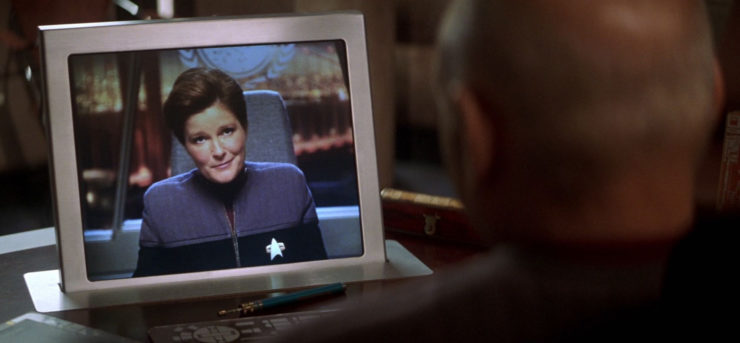
The other ships in that aforementioned fleet include the U.S.S. Intrepid (mentioned in both TNG’s “Force of Nature” and Voyager’s “In the Flesh,” the ship for which Voyager’s class of ship was named), the U.S.S. Valiant (a new ship with that name, as the one seen in DS9’s “Valiant” was destroyed), the U.S.S. Galaxy (the ship for which the Enterprise-D’s class of ship was named), the U.S.S. Aries (a previous ship that Riker was offered the captaincy of, which he turned down in TNG’s “The Icarus Factor,” and also mentioned in TNG’s “Identity Crisis” and “Redemption II”; the ship was misspelled “Aires” on the computer display), the U.S.S. Nova, and the U.S.S. Hood (the ship Riker and La Forge both served on before reporting to the Enterprise-D in TNG’s “Encounter at Farpoint,” later seen in TNG’s “Tin Man” and LD’s “Mining the Mind’s Mines” and referenced in several TNG and DS9 episodes).
While the rest of the cast was last seen in Insurrection, Worf had continued to be a regular on DS9, and he was last seen in that series’ finale “What You Leave Behind” being given the assignment to be Federation Ambassador to the Klingon Empire. Several novels showed Worf as a diplomat, including Robert Greenberger’s Doors Into Chaos, John Vornholt’s Genesis Force, Dayton Ward & Kevin Dilmore’s A Time to Sow, David Mack’s A Time to Kill, and your humble rewatcher’s Diplomatic Implausibility, The Brave and the Bold Book 2, A Good Day to Die, Honor Bound, A Burning House, and A Time for War, a Time for Peace, among others.
Early drafts of the script had Crusher intending to become head of Starfleet Medical (which she’d already done during season two of TNG) and Wes becoming part of Riker’s crew on Titan. Your humble rewatcher reconciled Wes being in uniform with his still being a Traveler in A Time for War, a Time for Peace, which chronicled full lead-in (and also immediate aftermath) of this film. My reconciliation was later supported by Wes’ appearance in Picard. In that same novel, I established that Worf was originally to become Riker’s first officer on Titan (and like Riker and Troi, this mission to Romulan space was his last hurrah on the Big E), but after Data’s death, Picard asked the Klingon to remain on the Enterprise.
Buy the Book
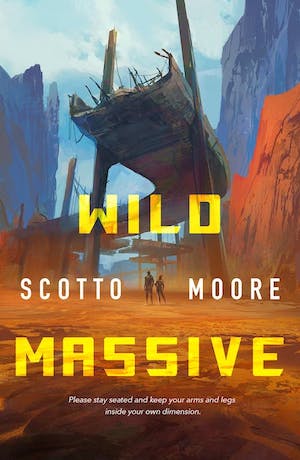

Wild Massive
As mentioned in the Insurrection rewatch, the A Time to… nine-book novel series by Vornholt, Ward & Dilmore, Greenberger, Mack, and your humble rewatcher chronicled the period leading up to this film. Among the things this book series did was chronicle the progress of Riker and Troi’s relationship from its renewal in Insurrection to their wedding in this film, show Riker being offered command of Titan, and establish how and why Worf was back serving in Starfleet from his diplomatic post.
The origin of the Remans was provided by the Vulcan’s Soul trilogy by Josepha Sherman & Susan Shwartz, which established that they were Romulans who were exiled to Remus and mutated by the conditions on that world (and who also retained their Vulcan telepathy, unlike the mainline Romulans). In addition, the last Romulan praetor we saw in power was Neral, as established in DS9’s “Inter Arma Enim Silent Leges.” The Vulcan’s Soul trilogy also chronicled the transition from Neral to Praetor Hiren from this film.
The short story “Twilight’s Wrath” by Mack in Tales of the Dominion War (which was edited by your humble rewatcher) shows Shinzon’s fighting on the Romulans’ behalf during the Dominion War, and also chronicles his discovery of B-4 and other bits of material he uses to further his plot in this film.
While the U.S.S. Titan is not seen in this movie, there is a series of Titan novels that give us Riker and Troi’s time on that ship, starting with Taking Wing by Andy Mangels & Michael A. Martin, which details the mission to Romulus that Riker describes at the end of this film. There were nine Titan novels (by Mangels & Martin, Christopher L. Bennett, Geoffrey Thorne, James Swallow, and Mack) plus an eBook novella (Absent Enemies by John Jackson Miller), and the ship was also prominently featured in the Destiny trilogy by Mack, the Department of Temporal Investigations novel Watching the Clock by Bennett, and in parts of the Typhon Pact and The Fall miniseries. Titan will later be seen onscreen in LD’s “No Small Parts,” and has appeared a few more times on that animated series as well. Picard’s “Nepenthe” will establish that Riker and Troi will have two children, but when one of them grows ill, they take extended leaves of absence to care for him until he dies. The Titan on LD is based on the design by Sean Tourangeau that won a contest for designing the ship held by Simon & Schuster, and which debuted on the cover of Sword of Damocles by Thorne. Titan will also be seen in Picard season three, but it’s a new ship with that name.
Besides the Titan series, several novels have dealt with the aftermath of the Romulan Empire’s travails in this movie: Death in Winter by Michael Jan Friedman, Articles of the Federation by your humble rewatcher, the aforementioned Destiny trilogy by Mack, and the Typhon Pact miniseries by Mack, Martin, David R. George III, Ward, Bennett, and Una McCormack.
Riker and Troi’s honeymoon was seen in the short story “Improvisations on the Opal Sea: A Tale of Dubious Credibility” by Mangels & Martin in Tales from the Captain’s Table (edited by your humble rewatcher).
The Enterprise-E’s adventures continued in fiction form beyond this, starting with a series of novels that showed the crew adjusting to the new status quo following this movie: the aforementioned Death in Winter, as well as Resistance by J.M. Dillard, your humble rewatcher’s Q & A, Before Dishonor by Peter David, Greater than the Sum by Bennett, the aforementioned Destiny trilogy, and Losing the Peace by William Leisner. The novels continued far beyond that, including being part of the Typhon Pact and The Fall miniseries, with the trilogies Cold Equations by Mack and Prey by Miller, as well as individual novels by David A. McIntee, Jeffrey Lang, Miller, Ward, and Mack. More recently, the Enterprise-E is seen in the Picard prequel novel The Last Best Hope by McCormack.
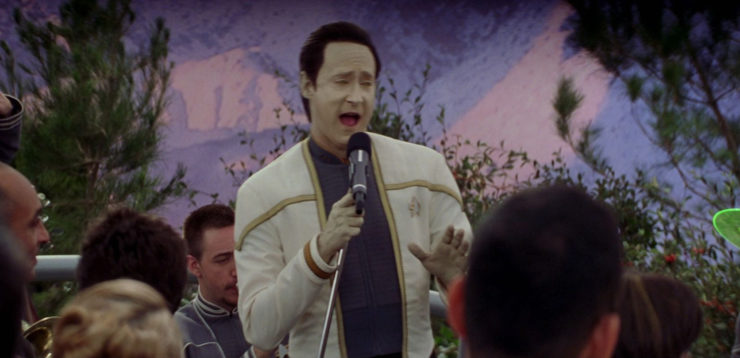
Make it so. “Why do you have a shiny head?” In 2002, I and several other Star Trek novelists who lived in the New York Metropolitan Area were among those who got invited to a special screening of Nemesis prior to its release. I distinctly remember walking out of that next to Michael Jan Friedman, exchanging glances and declaring that the movie was remarkably terrible. Indeed, we remarked on it for quite some time afterward…
Twenty-one years later, it isn’t any better. Picard show-runner Terry Matalas is on record as saying that part of why he’s getting the band back together for season three of the TV show is because he wanted the sendoff this crew deserves that Nemesis utterly failed to provide, and hoo-hah, he ain’t kiddin’.
There are a lot of failure points in this movie, but every time I watch it and/or think about it, I always come back to this: when Picard and the gang beam over to the Scimitar the first time it’s stated very clearly that Remans are susceptible to bright light. So when the viceroy leads a boarding party, my first thought in 2002 was, “Okay, here’s where Picard orders the lights turned on really really bright,” a moment that never came, and what the hell? That is Writing 101! There is no reason, none, to have the Remans be sensitive to bright light unless you’re going to use it in the story. But it’s never even mentioned after that, and it makes our heroes look like complete morons, because the obvious defense against the boarding party is staring them right in the face!
When I did my rewatch of The Wrath of Khan, I talked about the many sides of the argument about whether or not someone who knows Trek should work on Trek, an argument that started with Harve Bennett and Nicholas Meyer taking the reins of the movies away from Gene Roddenberry in that 1982 film, and continuing to the present in arguments about the shows on Paramount+.
This movie is a great argument against the notion of outsiders coming in. John Logan and Stuart Baird were specifically brought in as fresh blood, and man, did they shit the bed. We start with two WTF scenes of epic proportions: the Romulan Senate turned to pixie dust by a device that was just left on a desk, with everyone just staring at it for several seconds while it blasts radiation into the room. Why doesn’t this government installation have any security? (This actually was particularly ridiculous to watch in 2002, only a year after 9/11.) Then we have Picard’s low-comedy best man speech for Riker and Troi, in which we hear words come out of Sir Patrick Stewart’s mouth that sound more like they should be coming from Seth MacFarlane’s Ed Mercer than Jean-Luc Picard.
And it never gets any better. Like with Insurrection, there’s a lot of forced humor here, complete with wide-eyed smiles coming from the crew in response during which you expect to hear a muted trombone go “wah-wah.” There’s Worf’s being hung over (ha ha! the big strong Klingon can’t hold his liquor! that’s funny!), there’s the “Mr. Troi” line (Zombie Henny Youngman called, he wants his outdated hoary sexist joke back), there’s Picard and Riker’s stupid banter about going on away missions on three separate occasions, there’s the tee-hee adolescent idiocy regarding Betazed’s tradition of nudity at weddings (hyur hyur, naked bodies is funneeeee!), and on and on.
Plus we have the captain’s mid-life crisis-mobile, the Argo, complete with aliens who fire on them for no reason the script can be bothered to explain. Nor can the script be bothered to explain why everyone’s okay with this pre-warp society being exposed to a shuttlecraft and a Space Dune Buggy who proceed to shoot them with ray beams. I know I’ve complained about modern Trek’s absolutist adherence to the Prime Directive, but this is too far in the other direction…
I could go on and on about this movie. It’s just awful from the bottom up and it’s awful from the roof on down the other side. The themes of duplicates and similarities between beings who started from the same spot are ham-fisted and underdeveloped, and ultimately not that interesting. Data’s sacrifice is ridiculously constructed. Besides the Argo car chase, we’ve got a middle-aged human going through the Scimitar easily taking out an entire ship’s complement full of trained soldiers who survived being cannon fodder in a brutal war, er, somehow. The shifting alliances of the Romulan military make no sense on any level—not their initial alliance with Shinzon, nor their later switch (though Donatra’s change of heart is understandable given how Shinzon treats her). And at no point do I feel like I’m necessarily watching the characters I’d been following for fifteen years up to that point. With very few exceptions, the characters barely even sound like themselves—or like anybody else. The dialogue is incredibly generic. (One very well-done exception is Riker’s reminisce of the first time he met Data on the holodeck, with the android failing at whistling, in “Encounter at Farpoint.”) And the telepathic rape of Troi is utterly gratuitous and pointless; it’s typical for a TNG movie to marginalize everyone not named Picard or Data, but it’s particularly appalling that the only thing they can find for the trained therapist to do in a movie full of psychological issues for the main characters is to have her be raped.
Worse, the movie utterly wastes Ron Perlman in a pointless henchman role that could’ve gone to anyone. Tom Hardy, at least, does a good job—and man, he looks so young!—but making a silk purse out of a sow’s ear has become his thing in several movies (most notably the two Venom films).
Ultimately, though, the biggest failure of this movie is a fundamental plot one: Shinzon’s entire cunning plan to get Picard to Romulus depends on factors completely out of his control and impossible to predict. What if another ship found the positronic emissions? What if Starfleet Command sent a different ship—or, y’know, a diplomatic envoy like, say, the Federation Ambassador to Romulus, who’s probably already there—to meet with Shinzon? What if Picard politely asked Janeway, “Can you please send someone else? I’ll never hear the end of it from the mother of the bride if we’re late…”
On Thursday, we’ll take a look at the attempt to redeem this nonsense with my review of Picard’s season three premiere, “The Next Generation.”
Warp factor rating: 1
Keith R.A. DeCandido has been writing for and about Star Trek since the turn of the millennium, including 16 novels, 13 novellas, eight short stories, six comic books, a reference book, and a bunch of RPG material, as well as reviews, articles, think-pieces and rewatches for a variety of magazines, essay collections, and web sites, including on this site since 2011. His next work of Trek fiction is coming in April: the DS9 short story “You Can’t Buy Fate” in issue #7 of Star Trek Explorer.










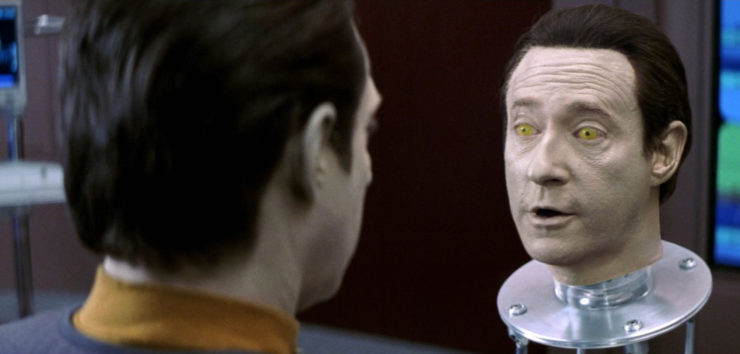
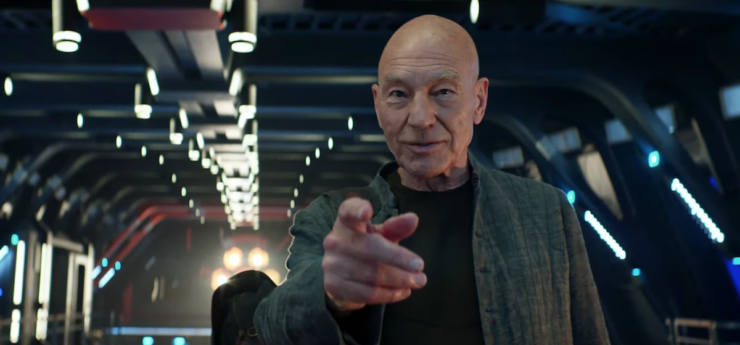
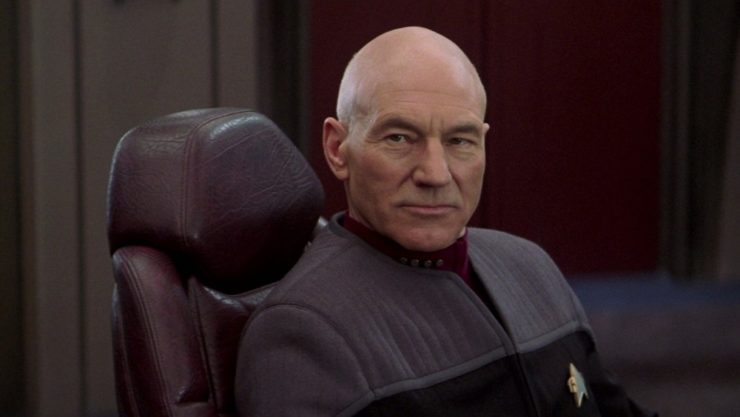
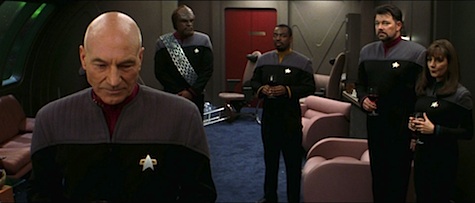
If nothing else, this film gave me my favorite instance of Chuck Sonnenburg’s ‘Psycho Janeway’ running gag over at SF Debris.
But anyway…I completely agree, Keith.
A lot of my issues with the film…they’re still there, but they’ve also faded in the 20 years between the then-end of the 24th Century multimedia, Trek going on hiatus after the Berman-era’s implosion, and Picard Season One and some of what it did (Romulan worldbuilding, a more emotional sendoff for Data).
But as a TNG sendoff, this film absolutely failed. So regardless of my many issues with Season Two of PIC, I am with Terry Matalas on giving the franchise’s second most famous and important crew — the one that proved the sandbox could endure and survive beyond Kirk, the 1701, and the 23rd Century — the farewell they deserved.
Is it not long established that Betazed is a matriarchal society, and therefore that calling Riker “Mr Troi” is actually perfectly consistent with Betazoid tradition, rather than a joke? Did not Deanna’s father Ian take the Troi name from Lwaxana before her?
Dear @krad, I can only hope that watching NEMESIS will make it easier to have fun with ENTERPRISE once you get back to that rewatch (from this particular low you can only go up, although there’s no guarantee it will be HIGH up).
Also, for some reason I find that Starfleet task force (With USS Galaxy et al) absolutely fascinating, partly because of the presence of no fewer than three name-ships of their class (special mention to the ‘Big Gal’ herself, who seems to be using up all the luck for her class the way RMS Olympic did for the White Star liners) and partly because this is very much an A-Team being put together to do some serious good.
It makes one wonder what the history of these ships and their crews look like, to say the least.
DS9Continuing: there’s no onscreen evidence, one way or the other, that Ian Troi took Lwaxana’s name. For that matter, there’s no onscreen evidence that Betazed is a matriarchal society.
Finally, the movie itself played it 100% for laughs with everyone on the bridge chuckling at the joke the captain just made at the first officer’s expense.
—Keith R.A. DeCandido
I’ve seen this movie a few times and I still can’t tell you why Shinzon wants to destroy Earth, and, unusual for a Trek story, I never cared to read any books or Memory Alpha or similar sites to figure it out. ‘It’s all so dull anyway, why bother,’ is the impression it had on me. No wonder nearly all the actors looked like they’d rather be somewhere else.
I know some fans like to point to the Abrams movie as the point when Star Trek fully became a big dumb action franchise instead of a semi-brainy sci-fi series with some action elements, but Nemesis was that point for me. Oh wow, I thought, this is a whole lot of melodramatic space opera hooey. Even the baddie looks like Ming the Merciless.
Though the clips and trailers have yet to convince me, fingers crossed Picard season 3 can at least be better than this.
I like Nemesis more than most Trek fans do–or perhaps more accurately, I dislike it less–but I always felt it was a massive mistake for Shinzon to be a clone of Picard when he could have just been an ordinary human. For one thing, why did the Romulans make a clone of Picard way back then when he was just an ordinary Starfleet officer, a long ways from being a captain or a person of major importance in the Federation?
It becomes even more ridiculous when Picard looks at the picture of Tom Hardy as his younger self and Hardy looks absolutely nothing like Patrick Stewart beyond the bald head.
One very minor nit: it could be argued that Picard’s next appearance is actually in the Short Trek “Children of Mars”, even if it’s only his image on a screen.
Reposting my old comments again:
I’m one of the few people, it seems, who really like Nemesis. Oh, I agree it has problems. The whole dune-buggy chase was a completely pointless bit of action, part of the problem I complained about in the Insurrection rewatch about how the films were forced to tack on action beats because of the cultural prejudice that SF films have to be action rather than drama. And conversely, a vital scene between Picard and Data which set up so much of the thematic and character arcs for what followed was completely cut out because of “pacing.” And there are very problematical elements like why Picard didn’t see it coming that Shinzon would attack the moment they entered the nebula that would cut off their communications, or the whole thing with the tiny portable transporter. (Are we supposed to believe the transporter is actually inside that teensy thing? How can a transporter dematerialize itself and still function? I’d like to think it was just a remote control for the Enterprise transporters, but they were said to be offline.)
But there’s a lot about this movie that I think is smart and well-done and I think it redeems most of the rest. In particular, I think the Picard-Shinzon relationship is the best captain-antagonist relationship in all the Trek movies. Talk of clones aside, it’s really a father-son narrative at its core — Shinzon is the son Picard never had, but he resents and rebels against his “father”‘s attempts to shape and guide him because he chafes at living in his father’s shadow. That’s why he tries to destroy Earth, as he specifically explains in dialogue: because he wants to overshadow Picard and erase his accomplishments from history. He doesn’t believe he can really be himself until he destroys the man he’s a copy of, and destroys his legacy as well. Sure, it’s a contrived way to inject a threat to Earth in the movie, but it still has a character-based justification that I’m okay with.
And it’s the interplay between two strong actors, Stewart and Hardy, that makes it really compelling. One may quibble about Hardy not really resembling Stewart, but that’s just theater. They’re actors playing roles, and we suspend disbelief. (Heck, Hardy resembles Stewart more than James Cromwell resembled Glenn Corbett.) It’s the performances that matter, and the interplay between these two men is intriguing to me. Certainly much more intriguing than the confrontations in The Wrath of Khan, where the screenwriters couldn’t even figure out a way to structure the story that allowed the hero and villain to be in the same room at the same time.
Along with INS, it’s also one of the few Trek movies to try to explore the kind of philosophical questions the shows explored. In this case, is it nature or nurture that determines our identities? Would we be the same people if our upbringing had been different? Are our actions really a matter of free will and choice, or are they dictated by the conditions that shaped us? That’s where the optimistic, Trekkish message is, the statement about human betterment. Shinzon makes excuses for his evils, blaming them on his past or his circumstances or on the Romulans or on Picard. And so he’s trapped, unable to change because he denies responsibility for his own actions. But Picard and Data recognize that they can choose to become better people by constantly working to improve themselves. And that’s the whole message of the Trek franchise — that humanity can choose to make itself better, that we’re all fallible and have a dark side but we can rise above it as long as we keep striving toward our ideals.
One of the things I like about the movie is the intricate politics, which feel very real to me. You can tell that John Logan has studied his history. I get so tired of alien empires that are not only ethnically but politically monolithic. It’s good to see a portrayal of the Romulans that includes clashing factions and infighting. (Well, I guess we saw that with the Klingons as well in TNG, but this felt more realistic to me somehow, perhaps because it was without the overblown Space Viking bombast of TNG-era Klingons.) I particularly like giving them a subject race in the Remans. It makes no sense how many Trek “empires” have only one species in them. An empire, by definition, is one state ruling over others. Adding the Remans makes the Romulans feel like an actual empire for the first time ever. (Which is why I hate the novels’ retcon that they’re mutant Romulans.)
@7/Tyler: “For one thing, why did the Romulans make a clone of Picard way back then when he was just an ordinary Starfleet officer, a long ways from being a captain or a person of major importance in the Federation?”
This is a common misconception. People are always forgetting that Picard was captain of the Stargazer for a whopping 22 years before he became captain of the Enterprise-D (plus an unexplained gap of 9 years between ships which I chronicled in my novel The Buried Age, shameless plug). The idea behind the character is that he was already a legendary explorer when the series began — that at the start of TNG, he was already where Kirk had been around the time of TWOK or later, an older, established officer who’d already made his reputation as one of Starfleet’s greats. That’s why they made him the captain of the Federation’s flagship in the first place. Riker was supposed to be the Kirk-analogue, with Picard as the elder statesman who trained and guided him. But Patrick Stewart ended up stealing the show and adopting a more central, active role, which made him seem younger, I guess. And his past aboard the Stargazer was rarely explored. So fans often overlook the fact that he was supposed to have already had a glorious career before TNG started.
It seems likely that the Romulans planned to clone multiple officers, that Picard was just one of numerous prominent Starfleet figures. Maybe the others died in the mines of Remus, or might even still be there.
The treatment of Troi is terrible and gratuitous, the car chase is stupid as hell, and there are are several plot holes. But to be honest, I actually like this movie quite a bit for all of the reasons that @ChristopherLBennet mentioned above.
This will never be my favorite Trek film, but I thought it was alright. I readily admit to being easily pleased, but really I thought it was fine (except for the dune buggy scene, which was obviously just inserted because Patrick Stewart wanted to drive something, and the mind rape, which, apart from being gratuitous, we already saw on the TV show). I liked the regulars, I liked Tom Hardy, I liked the Romulans. I didn’t really care for the design of the giant evil spaceship, but I guess it did it’s job, which was to look big and scary.